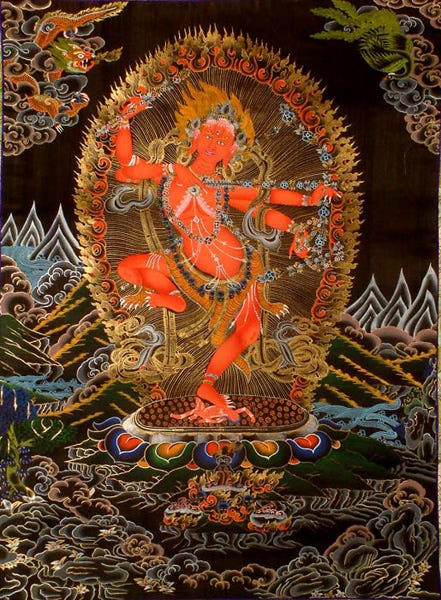
How to Find a Tantric Healer
Whether you call it sexual healing, sensual healing, tantric healing, sexological bodywork, tantric massage, tantric instruction, or good old erotic massage… finding the right practitioner can be hard!
Are you interested in learning tantra, but don’t know where to start? Are you curious about tantric massage (or yoni massage, or lingam massage, or sensual massage) but are terrified of booking an appointment? Have you heard about tantric healing (or sexual healing, or sexological bodywork, or sacred intimacy, or sexual surrogacy, or erotic energy work) but have no idea how to find the excellent practitioner who is exactly right for you?
You are not alone.
Most people take their first steps on this path with trepidation — and rightfully so! This kind of hands-on, experiential work, often involving sexual energy and/or intimate touch, can quickly get to the root of deep-seated issues that often take years to resolve with other methods such as counseling or medical treatment. Tantric healing can have a dramatic, positive effect in a person’s life when undertaken by a well-trained, gifted practitioner. But it can also be traumatic and truly damaging when the practitioner is unqualified or unethical.
This article is a comprehensive step-by-step guide, written by an experienced tantric healer and tantra teacher, based on years of helping people find exactly the right experience.
Before you begin looking:
Know what you want!
The single most important place to start looking for your practitioner is in your own heart. The more clearly you know what it is that you want or need, the more effectively you can find the perfect practitioner.
Fortunately, you don’t need to be an expert in this stuff! You don’t need to know the difference between lineages or schools. You don’t need to be a master of tantra or energy or chakras or kundalini. All you need to be able to do is to know in your heart what it is that you want, and to gather the courage to ask for it.
It will often happen that a person is curious about many aspects of this field and “wants it all.” This is fantastic, but it is not the best way to start. Find what it is about “all of this” that most speaks to your innermost desire, beginning with the essential question of whether there is something unsatisfying that you want to address, or are you looking to explore into new territory of experience?
Here are some more specific questions you might ask yourself:
— “Do I have sexual dysfunction or a block to pleasure that is impairing my ability to have a satisfying sex life?”
— “Does my sexual energy seem to be out of balance somehow? Do I have a libido that is higher or lower than I want it to be?”
— “Have I had sexual trauma that might be interfering with my ability to have good sex or genuine intimacy?”
— “Am I in or coming out of a difficult, manipulative, or abusive relationship?”
— “Do I have body image or self image issues that leave me feeling like I will never have the relationship I want?”
— “Do I want to learn more about my body and the possibilities for sexual pleasure?”
— “Do I want loving, sensual touch in a way that I am not getting in my life right now?”
— “Am I interested in the union of spirituality and sexuality, or sexual mysticism?”
— “Do I want to learn techniques to deepen intimacy with my current or future partner?”
— “Do I want to learn some particular sexual technique or have some particular sexual experience?”
— “Do I want to prepare myself for and/or manifest my next partner?”
— “Do I have patterns of relationship or partner selection that are leaving me with unfulfilling relationships?”
— “Do I want to re-learn my patterns of relating sexually so I can bridge an emotional gap between sex and love?”
A lot of questions, to be sure — but they only scratch the surface. When you find the most pressing and powerful interest that calls you to this experience, you can narrow the focus of your search for a practitioner that truly meets you at the place of your deepest desire.
Know your rights!
In the United States, and most other parts of the world, tantric healing is not regulated by any government agency. Just about anyone can post an ad on craigslist calling themselves a sexual healer. Being clear about what you should expect from a practitioner will help you quickly weed out people who are not genuine professionals.
Additionally, Tantric session work may involve significantly more physical and emotional vulnerability than a simple massage. It is wise to be able to identify whether a prospective practitioner is going to create a safe environment for you to heal, learn, or grow.
My companion article, A Tantric Bill of Rights, outlines what you should expect — and what you can request — from a tantric healer. By thoroughly familiarizing yourself with these reasonable expectations, you can approach your quest for a practitioner with more clarity and confidence. Take the time to speak with several practitioners and choose a person to work with whom you trust. And, more than anything, it is trust that maximizes the value you get from the experience.

Understand Some of the Basic Terms
Here is a very quick guide to some of the ways practitioners may present themselves or their sessions, and some related terminology:
“Sensual Massage” — This can range from a delicious (but traditional) massage for the purpose of pleasure, to an erotic “happy ending” massage. A sensual massage is a perfect choice for those seeking pleasure and relaxation, and who want to incorporate intimate touch into their massage experience. There is not usually a healing intention, but as with all pleasure and human touch, healing happens.

“Tantric Massage” — A tantric massage is the centerpiece of tantric healing. This modality is a perfect choice for those seeking pleasure and relaxation. It is often a useful modality for learning more about your body, about subtle energy, and about your potential for pleasure, connection, and intimacy. The practitioner of a tantric massage is usually called a daka (m) or dakini (f). A true tantric massage from a qualified daka or dakini will include traditional massage, but also sensual touch and, depending on the practitioner’s style, some combination of energy movement, guidance around mindfulness, and coaching of breath, sound, or motion. The usual expectation is there will be intimate touch (at least external, and optionally internal) and the sexual energy that accompanies it. However, this is not always the case: some dakas and dakinis use sexual energy without sexual touch as a rule. Tantric massage is also the starting point for exploring tantric teachings and experiences of sacred sexuality. It is important to note that there are many practitioners who advertise their service as “tantric massage,” but use that term as fancy or coded name for a sensual massage that has little or nothing to do with tantra — hoping that the exotic allure of tantra will attract clients. It’s worthwhile to ask a tantric massage provider about where they received their training, or to describe what the session will be like. You can expect a true daka or dakini to include practices involving energy, breath, gaze, sounding or mindfulness as part of the session.
“Tantric Healing” — This is often another term for tantric massage. When someone in the tantra world talks about a “healing session,” they generally mean a particular flavor of tantric massage. The difference is in the intention of healing — which can encompass physical, emotional, energetic or spiritual healing. Tantric healing often uses sexual energy as a healing tool, but can include a much broader range of energy and shamanic work.
“Sexological Bodywork” —This is another form of sensual massage that is often used for healing or educational purposes. The Sexological Bodywork organization is part of a movement to gain broader societal acceptance for sexual healing by establishing clear purposes and professional standards for bodywork that involves intimate touch. This modality has gained limited legal recognition in California, as well as full support in Canada and some other countries. The Sexological Bodywork organization trains “SexBod” practitioners with an emphasis on safety, professionalism, and a slightly more clinical intention than the other modalities discussed here. Sexological Bodywork sessions are not clinical in a medical sense, but the focus tends to be more on the physical aspects of the session. Practitioners use gloves, remain fully clothed, and often do not enter into any of the “sacred sexuality” dimensions common in tantric healing and sacred intimate sessions.
“Yoni Massage,” “Lingam Massage” — These are massages involving intimate touch. ‘Yoni’ is a tantric term for the female genitalia, ‘lingam’ for the male. They are not necessarily separate experiences from a tantric massage, but they may indicate more emphasis on the intimate touch.

“Dakini,” “Daka” — These are recent terms used to refer to a tantric guide. The dakini (f) or daka (m) may work in sensual and sexual healing modes, but the term can also be used for other kinds of tantric guide. Some work primarily as coaches, as spiritual guides, and the tantric healing they offer may not involve intimate massage. Most commonly, however, dakas and dakinis offer tantric healing. (Historically, there is no evidence for the term ‘daka’ in classical tantra, the dakini was a woman who had mastered tantric powers, and could use them in healing — or frightening — ways.)
“Sexual Surrogate” — Sometimes just called a surrogate. In its “correct” usage, this is a practitioner who does hands on work under the guidance of a licensed sex therapist. The ‘surrogate’ refers to the fact that the practitioner does what a sex therapist is forbidden by law and professional standards from doing — but which the client may need. Surrogates provide hands-on, experiential guidance, even building up to and including sexual union (i.e., intercourse). One key difference between the modalities listed earlier vs. sexual surrogates and sacred intimates (described below) is the openness to mutual touch. These two modalities are well-suited for clients seeking to learn sexual techniques or to become comfortable with sexual touch (as may be the case following trauma or a long time without sexual interaction). A good sexual surrogate — like a good daka or dakini — maintains professional boundaries with his or her clients that ensure both parties’ physical and emotional safety.
“Sacred Intimate” — The sacred intimate is another term for a practitioner using sexuality in a healing way. A sacred intimate is very much like a sexual surrogate, but without oversight by a licensed sex therapist. Because of this, the sacred intimate is the one guiding the healing/learning process (in collaboration with the client). Not all sacred intimates actually do hands-on sensual healing work, but those that do generally include mutual touch and may include sexual union.
Often, an experienced practitioner will work in more than one of these roles or capacities!
Now Start Looking!
But where?
Word of Mouth
This may seem unlikely at first, and you may not want to tell your close friends you are looking into sexual healing. TMI!
That said, the best source of good information about practitioners is by people who have been to one. So, if you don’t already know someone like this, you might look around on internet forums, facebook groups, and local alternative journalism to see if anyone in your area has had experiences that sound like what you want.
Some progressive sex therapists and sex educators may be connected to hands-on practitioners. The sites below have lists by location who may be good sources of referrals:
- Psychology Today (filter your locale by the “Sex Therapy” issue)
- American College of Sexologists
- AASECT
Another way to find a local practitioner is to find a top practitioner who is not in your area, and ask for a local referral. Tantric practitioners tend to know who among their peers is most qualified, and may be able to steer you well.
The Internet, of Course
There is no comprehensive or authoritative index of tantric practitioners and other sexual healers. One of the most reputable sites for professional practitioners of various schools and traditions is the Sacred Eros Directory. Many schools provide indexes to their practitioners, so it’s also worth reviewing:
- Source School of Tantra
- International School of Temple Arts (ISTA)
- Sexological Bodywork Institute
- Authentic Tantra
- Skydancing Tantra
- Sexual Surrogacy Association
It is less reliable to look at advertising venues such as craigslist or backpages. You can occasionally find a terrific person who is early in their career looking for clients, and if your primary desire is for a simple sensual massage, you can find affordable practitioners this way. But if you are looking for deeper healing or growth it is generally not a good use of your time.
You should also google for your area. Examples:
- Tantric healing <city>
- Tantric massage <city>
- Lingam massage <city>
- Yoni massage <city>
Top, experienced practitioners should appear in the first two pages of search results.
A Note on Gender
Generally speaking, there are far more women doing this work than men, for the simple reason that there are far more men looking for this service than women. It will be easier to find a female practitioner than a male practitioner, and some of the male practitioners will also be primarily working with male clients.
Even with a healing intention, it can be most powerful to work with a practitioner of the gender you are primarily attracted to. The use of sexual energy and sexual polarity along with the creation of a safe space can be the most powerful way to release traumatic experiences and memories. That said, people with extreme trauma may want to begin with an approach that avoids directly confronting those traumas and working with a practitioner of the gender opposite to the perpetrator of trauma.
By way of example, a straight woman wishing to overcome vaginismus (vaginal tightness and pain) that arose after a sexual assault by a man may want to eventually work with a male practitioner. A daka can provide a template of loving, trustworthy male sexual touch that can allow women to release apprehensions and fears around sexual intimacy.

What if there’s nobody near me?
If you are outside major urban areas, there may be no practitioners in your locale. In that case, you may want to plan some travel! As mentioned above, tantric healing massage in particular has a way of getting to the root of deep-seated issues quickly, often in just a few sessions. Many clients are surprised to find that issues they’ve been working with talk therapists or even medical professionals for years to address are largely resolved in just a few sessions. It may seem like a big investment, but the sheer efficiency of a talented dakini or daka is well worth it. It’s important to note that if you are seeking out tantric healing, plan on at least 2–3 days between sessions to allow yourself to process and integrate each experience.
Some practitioners will be glad to travel to you, and some practitioners travel as a matter of course. You will see that some practitioner websites have multiple locations on them. Find out when their next trip to your area might be. If they are already traveling to an area near you, they might be up for a detour! Do be aware that providers often charge more for sessions away from their home base.
Finally, if you are already planning your own vacation, some practitioners will do “vacation intensives” — multi-day experiences that may include not just bodywork sessions, but sometimes yoga, meditation, coaching or other elements, too. These VIP experiences usually includes either fees for all the individual services or a flat daily rate, plus payment for the practitioner’s travel, room, and board. This is obviously a “high end” option, but there is nothing like getting a week’s worth of healing, teaching, and intensive 1:1 work in a beautiful location with nothing but rejuvenation on the agenda.
Review Your Options
So, perhaps now you have a list of options! Maybe even too many choices! What to do?
This is where the first step “Know what you want” comes in. With a list of possibilities, review the website of each prospective practitioner. See whose personal statements and service descriptions resonate with you and best match up with your desire.
This is also the first challenge to trusting your intuition. If you have any sense from any of the websites that this person is not for you: trust that intuition. You are going to need to continue to trust your intuition throughout this process, and this is where to start.
Here are a few things not to emphasize:
- Price. Many practitioners are willing to offer some form of sliding scale for those who bring a genuine need. Many, but not all: more experienced practitioners simply have so much demand they could work themselves sick to meet the needs of their community. If paying your preferred practitioner’s rate presents a real hardship for you, it never hurts to inquire about their pricing policies.
- Training. Depth of training (or the absence of it) does not necessarily mean the practitioner is or isn’t the right one for you. A long list of certifications is certainly not a bad thing: it indicates the practitioner cares deeply for this work and has a love of learning. But if your intuition is pointing away from a practitioner, don’t let a list of credentials persuade you otherwise. Likewise, if you feel drawn to work with someone who lacks credentials, you can find other ways to verify their skill. Any practitioner should be glad to put you in touch with satisfied clients; if a certain practitioner is hesitant to, consider that a red flag.
- Sexy photos. For most intentions, physical attraction is really not relevant. You’re not looking for a romantic partner! You’re looking for a skilled and gifted healer, teacher, and guide. But if there are a lot of photos, spend some time with their eyes. Let your intuition read the face of the practitioner.
- Testimonials. Everyone has some good sessions and can get some positive feedback from clients. Testimonials are a lovely part of many websites, but heck — they can be made up by the practitioner! They are worth reading, but don’t rely on testimonials alone.
Schedule a Consultation
Are you down to a short list? Maybe even one practitioner? It’s time to exercise your first right as a client: a brief, no-cost conversation.
You have one primary objective for this conversation: Can I trust this person?

Some practitioners will be able to make time for a face to face meeting; others won’t. Some may prefer to talk to you initially over a phone call or a Skype chat. You should expect a consultation to last 15–30 minutes. (Note: there is an unfortunate tendency for men to claim to be prospective clients, and waste the time of female practitioners with dubious “consultations” — and as a result, not all dakinis will offer a phone consultation without a compelling reason. You might need to convince her via email that you are serious, worth her investment, and that a phone call would help you finalize your decision. Think Inara in Firefly.)
If there were any information gaps in the website (and remember that not all practitioners are going to be web gurus!), use this time to fill in details.
Here are some questions you might consider asking, especially if the website didn’t address them:
— “What got you into this work?”
— “Who was your favorite teacher & why?”
— “What do you bring to you sessions that sets you apart from other practitioners?”
— “What kind of sessions are the most fulfilling and fun for you?”
— “Can you describe your ideal client?”
Your prospective practitioner may ask you to describe yourself, your situation, and your intentions and desires for seeking out this kind of bodywork. If not, be sure to offer this information! Then, ask, “How would you approach my situation?”
You want to listen to their answers, of course. But you also want to listen with your heart. Is the practitioner listening to you? Do you hear sincerity and caring in the voice?
Ultimately, at the end of this conversation, you are going to want to be able to confidently make an appointment, or confidently continue your search.
Get the Most out of your Session
This is a big topic, and requires a full article!
Extra Tips for Women Seeking a Male Practitioner:
It is unfortunate that this needs a callout, but the fact is, it does.
As noted above, there are far fewer male practitioners than female ones, and because of the economic imbalance, many male practitioners are not as experienced or not as serious as female practitioners.
And, the truly unfortunate truth is, male practitioners have been known to cause harm. The female client wanting to work with a male practitioner should take extra steps to ensure safety: you want to work with an intuitive, competent, qualified professional who specializes in the area you want to explore.
But don’t be scared off! The healing power of masculine energy is enormous when it is brought in integrity. The templating that can happen when working with a great male practitioner is a powerful means of transformation.
One illuminating question is: “Is this your primary means of supporting yourself?”
If you are looking for serious healing, or if you are a serious student of tantra, you want a serious teacher. There are quite a few “hobbyist” practitioners out there… men who have done some training (or in some unfortunate cases, have only read an article that described yoni massage), but never committed to this as a profession. Not being devoted to tantra as a vocation doesn’t mean a practitioner isn’t fully qualified, but it is a warning sign that they might not be ready for a more challenging session.
Another important question: “Do you have a partner? Do they support you in this work?”
Because of our cultural and social sexual dynamics, the female client needs a practitioner who brings an abundance of loving energy to the session. A male practitioner without a partner (or partners) who is coming to this work “thirsty” for either love or sensual fulfillment may be seeking those things, even subconsciously, from this work. This may make it hard for that person to maintain boundaries. Again, this might not be an instant disqualification, but an unpartnered practitioner or a practitioner whose partner is not enthusiastically supportive is a warning sign.
A critical question is: “How do you maintain your boundaries?”
Be sure to read the many points around boundaries in the “Tantric Bill of Rights” article. A male practitioner who is not adamantly, 100% in support of strong boundaries or who gives any kind of wishy-washy answer here may not be a safe practitioner.
Tip: Look at his fingernails!
One detail that can be telling when trying to discern the professional from the hobbyist is the care of his fingernails. The professional practitioner will have short, smooth, clean fingernails. And believe me: you want him to have short, smooth, clean fingernails!
What Next?
Congratulations! You have found a tantric healing practitioner.
May this be the beginning of new realms of intimacy and pleasure for you and your partners!

